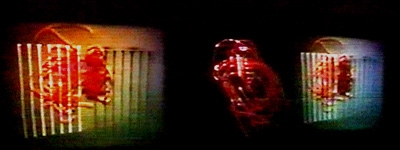
1971, UK, n. 3 screens 16mm, colour, sound, 8 min.
Starting out working with painting and drawing, at the beginning of the 1970s Gill Eatherly joined the London Filmmakers' Co-op and began working with film. It was in the same period that she became part of the Filmaktion collective (in which Malcolm Le Grice also took part) who organised a number of expanded cinema events around London. Unlike other British experimental film-makers of the period, Eatherley does not exclusively anchor her work in structuralist theories of movement. Her films are perhaps more connected to the interdisciplinary concepts that were around at the time in the fields of music and art, as shown by Hand Grenade. This is a playful work where three orchestrated screens accompany music by the group Neu. It may seem that the images in Hand Grenade are those of an oscilloscope, or are generated by a computer. However, the film was actually created by painstaking work with an optical printer.
…This short energetic extravaganza was the result of a massively laborious but traditional film-making process. The initial material was shot on 16mm black and white stock in a pitch-black space. Each single frame was exposed often for several minutes with the camera shutter open whilst Eatherley drew around various objects in space, including her own body, using a single low voltage flashlight bulb. She would than move a little in space and repeat the action for the next frame. It was a process of animation where the subject moved progressively in space. The objects being drawn were never seen directly - they could only be sensed or inferred by mentally linking the consistent end points of the light traces. As a result the object became a ghost - an absence defining a presence.
Malcolm Le Grice, adapted from Gill Eatherley, Sept 2004
